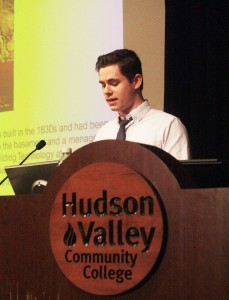Green energy advocate discusses her work

Jefri Nazri
Staff Writer
On Tuesday, Feb. 24, TEC-SMART adjunct professor Joanne Coons visited the Hudson Valley campus to share her journey towards transforming an abandoned historical farmhouse built in the 1830s to a net zero energy consumption house. The title of her Voices Library Lecture Series talk was “Rehabbing a Historic Farmhouse into a Net-Zero Energy Green Home.”
William Kent, a nursing major, introduced Coons to the audience as an adjunct professor at TEC-SMART and an organizer for the Capital Region’s chapter of the New York Energy Society. “She practices what she preaches, in having brought an abandoned farmhouse built in 1830s back to life, creating from the ruin a net zero energy consumption home,” said Kent.
A developer suggested Coons and her husband to take a look at an old farmhouse that nobody seemed to want to buy. Coons said that they had good vibes upon seeing it for the first time and decided to buy it and start the project of rebuilding the house. They had three goals for the project: to keep the historic structure, to use green building practices, and to achieve a net zero energy. “We’ve gone to lectures and attended conventions, and did a lot self-learning and reading on the internet,” said Coons.
“We had an architect draw conditions up, and we took a look at how to improve livability and design it to be energy-efficient while keeping its historic core.” said Coons. The house now features solar electric panels, a solar hot-water system, closed cell foam insulation, a ground-source heat pump for heating and cooling, WaterSense fixtures, and ENERGY STAR appliances.
Coons’s life goals are eliminate the use of fossil fuels and to reduce energy consumption.
Coons showed the audience an image of her house in the wintertime, pointing out that it lacks icicles. She explained that the formation of icicles is an indicator of poor insulation. “Right now, during our brutal winter months, the icicles that are hanging are indicators that heat is being lost through the roof. I have heard recently about ice dams, water damage, shoveling roofs etc. All this would not be necessary with proper insulation so the ice doesn’t form,” said Coons.
She continued, “Instead of pumping more expensive fuel to replace the heat loss from a building, a free energy audit by NYSERDA would stop this negative feedback cycle. Investment in making our buildings energy-efficient will have long term effects to save energy and money. This should greatly reduce our fossil fuel use and reduce carbon emissions. So the first step is to address the energy efficiency and then in the future add renewables. The order of operations is important. There is no reason to add expensive renewable energy to an expensive energy-hog building,” said Coons.
John Heiser, Director of Graphic Design and Printing Services, asked Coons, “How long did it take to finish the project?”
Coons said “A year. We started in January and we finished in December.”
India Meadows, a construction technology student, said, “I thought the talk was very impressive and creative. It has definitely inspired me more about green energy.”
“Technology is changing so fast that to keep up with these changes, we will be eternal students. I personally enjoy reading about new innovations and applications of technology. If we keep building the same shortsighted way based on cost and not function, our education is failing us,” said Coons.
